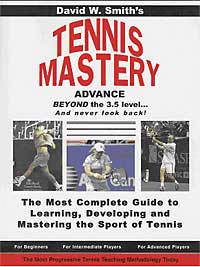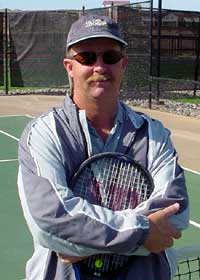|
TennisOne Lessons Simplifying the Service Mystery David W. Smith, Senior Editor TennisOne Although teaching the serve has been covered extensively among the many articles found here in our TennisOne Lesson Library, it remains one of the more complex and misunderstood motions in tennis. Add the fact that many players have had only limited exposure to overhead movements—especially those that involve the interaction between two moving objects (racquet and ball). You can easily understand why, for so many players, the serve is such a difficult stroke to master. Across the ball; At the ball When I teach the serve, I break the stroke up into easy to understand concepts; both, from a stroke development standpoint as well as a comprehension standpoint. From this simplistic approach to teaching the serve, I’ve developed a phrase to remind players of what the racquet is doing to the ball based on the desired amount of spin the player wants to impart upon the ball. The simple phrase is this: Across the ball; At the ball. With any spin serve, the strings must move across the ball. On the other hand, if you want more velocity and less spin, you must bring the strings to the ball more directly, thus I say “AT the ball” to create the perception of how I want to move the racquet to the ball for a flatter serve. Understand also, that there will always be an amount of spin added to even the “flattest” of serves. On the pro circuit, the average amount of spin on a flat serve varies between 1500 and 4000 revolutions per minute. There is virtually no way that a 130+ mph serve can land in the service box without some significant amount of spin applied. The difference is in how the racquet approaches the ball for a flat serve compared to the way it approaches the ball on a significant spin serve. Spin Serve In using my phrase, “Across the Ball,” the simple action of the spin-serve deals with the racquet brushing across the ball. But “Where” across the ball? The spin serve I teach all my beginners is the pure slice serve. In this case, across the ball would be referring to across the outside of the ball, or the “equator” of the ball as if the ball was spinning while held up by a string. (I also use the analogy of the earth as it spins on a north-south axis.) Using a “clock” analogy, you would be brushing across the ball at the “3-o’clock” position. Another analogy I like to use is a basketball player spinning a basketball on his finger. He keeps it spinning by stroking across the side of the ball in a fast, brushing action so as to not hit the ball off the finger. For a complete analysis of the different types of service spins, see my article “The Serve: Spin Axis, Body Position, and Swing Path,” found here in the TennisOne Lesson Library. Remember that each type of spin will require a slightly different swing path. The problem for many who are learning to serve is the use of the eastern forehand grip instead of the continental grip. The eastern grip squares the racquet up to the ball too much and severely limits the action of the strings in the quest to brush the side of the ball. Typically, the eastern grip amplifies the action of hitting the ball flat as the grip promotes a swing path that produces the “waiter’s grip” on the backswing, which in turn, causes the player to "cantilever" the racquet up and “AT” the ball in a very linear swing path. Flat Serves
As I mentioned earlier, all “flat” serves have some element of spin. The difference between a spin serve and a flat serve is the amount of spin relative to the amount of forward velocity the racquet applies to the ball. But, you can hit “AT” the ball significantly and still have brush. At my academy we teach the slice serve first. This brushing action teaches kids and adults alike, how spin will affect the flight path of a ball. Once a player can hit a serve well with spin, we introduce the second part of that simple phrase: At the Ball. In discussing this flatter serve, I usually use the “high five” analogy to get the student to imagine bringing the strings more AT the ball than ACROSS it. Within a very few number of attempts, students soon get the feel of hitting a flatter serve while incorporating the correct right grip and swing path. More importantly, they still impart some spin on these harder, flatter balls. Using the Correct Grip As I mentioned earlier, it is common for beginning players to gravitate to the eastern forehand service grip. This grip sets the racquet face in line with the ball and in line for the target
Once the player understands and experiences the limitations the eastern forehand grip, he may want to make the change to the more effective continental grip, however, this change can be frustratingly difficult especially when one considers the competitive nature of the game and its increasing emphasis on league and team play at the club level. The secret to using the continental grip correctly follows the simplicity of the phrase “Across the Ball” and “At the ball.” Most players, those especially used to using the eastern grips, will slice the ball well too far to their left (for right-handed servers), and end up reverting back to the comfort and confidence of their eastern forehand grip to correct this. Instead, with the continental grip, the player will want to stand more sideways and bring the hitting surface of the racquet to the ball from the edge-on position to a square position near contact. Among all good servers, this action is nearly identical. This turning of the forearm is called pronation of the forearm and it is what brings the racquet up from the edge-on position to a square position to the ball at contact. . The racquet first approaches the ball on the right side (for a right-handed player), and then creates the internal rotation of the forearm according to the amount of desired spin or flatness the server wishes to apply. Conclusion Remember, although contact on the serve is made well above the net, without significant spin, it would be impossible for a hard struck ball to land in the service box. In fact, a player would have to be almost nine feet tall to hit a "frozen rope" serve, one that has no downward arc because of its speed, to clear the net and still land in the court. Thus, even fairly tall players will benefit from hitting serves that have not only spin, but the right kind of spin. One of the problems I see in the way players serve is they don’t understand the clear relationship of what the strings are doing on a spin serve versus a flatter serve. This simple phrase of “Across the ball; AT the ball” will help you first comprehend the differences between the flat and spin serve, but more importantly, create an opportunity for you to discover more effective serves in the process. Your comments are welcome. Let us know what you think about Dave Smith's article by emailing us here at TennisOne .
|


 Your comments are welcome. Let us know what you think about this article by
Your comments are welcome. Let us know what you think about this article by